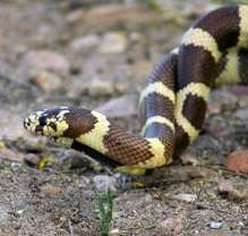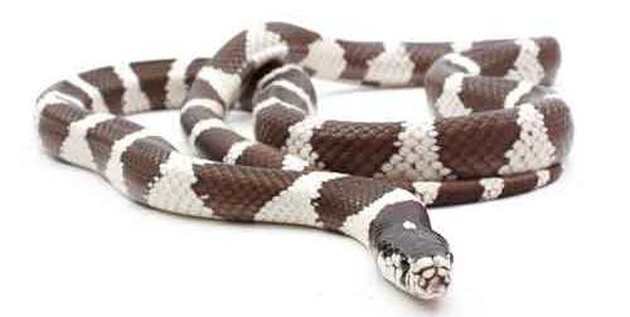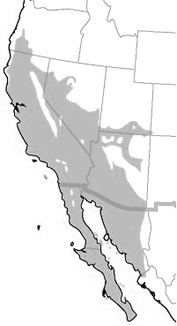California KingsnakeLampropeltis getula californiae |

Custom Search
|
|
The California Kingsnake (Lampropeltis getula californiae) natural habitat is, as the name implies, the great State of California, but they can also be found in Utah, Arizona, Nevada and even North Texas. These snakes are a relatively small subspecies of the common kingsnake.
The species is very adaptable, these snakes can live in forests, deserts, chaparral, grassland, woodlands, along rivers or farms even bushy suburban areas. They are normally found up to 1000 meters but can be found in elevations up to 2100 m (7,000 ft) in the Tehachapi Mountains region. This snake is more active during the daytime in the colder regions of its range. But with higher temperatures, the California Kingsnake becomes more crepuscular and nocturnal. In the winter, they will usually go deep underground and enter brumation a hibernation-like state which is characterized by the reduced activity and slowed metabolism. This non-venomous snake was introduced to the island of Gran Canaria in Spain, by the accident or the deliberate release of individuals that were bred in captivity. This is similar to other situations around the world where invasive snakes established themselves. Like the brown tree snake in the Pacific island of Guam, the Burmese pythons in the Florida Everglades or the mildly venomous wolf snake introduced to the island of Mauritius. This snake species is a constrictor, meaning, it kills its prey by squeezing them to death, and isn't venomous, although it is mostly immune to the venom of some other venomous snakes.
The California Kingsnake can reach a length between 110 and 150 cm, with the same width throughout most of the body, the head being slightly wider than the neck. It is found in several colors most commonly with alternating bands of black or brown with white or yellow.
A crossed out color variation can be found on the south coast of California, bearing a white or yellow stripe running along its back. Another pattern variation without lateral bands and stripes is also common in some parts of California. The California Kingsnake usually sheds 4 to 6 times per year, during this period they become "opaque" as their skin becomes dull and its eyes turn a milky white color, making them virtually blind. The Juvenile snakes shed more frequently than adults, up to once a month, because of their faster rate of growth. When it wants to signal distress, it will shake its tail rapidly, hissing, or curl up, hiding his head. The California kingsnake falls prey to many predators, among them are coyotes, opossums, hawks, owls, skunks and others. Due to their ease of care, attractive appearance, and docile nature California kingsnakes are among the most popular pet snakes. Snake enthusiasts and breeders have selectively bred a variety of color patterns called morphs. Diet / Feeding
California king snakes are opportunistic hunters, feeding mostly on rodents, birds, lizards and turtle eggs. They also feed on other snakes like the Western Diamondback Rattlesnake or the Cottonmouth since the species is somewhat immune to their venom. But if a large dose of venom injected into the snake's head or heart may kill it. This behavior gives the california kingsnake a good reputation with people in rural areas. From this ability to eat other snakes comes their common name "King", just like the King Cobra. They are also cannibals feeding on snakes of the same species. They find their prey by sight, detecting movement, and smelling, searching the ground, under rocks, and in shrubs. Like many snakes the California kingsnakes jaws are hinged, this feature allows them to swallow prey items larger than their head. Reproduction This is an oviparous snake species, meaning it lays eggs. The California kingsnake mating season runs from March to June and involves the males competing for available female snakes. The female will lay the eggs from May to August. It lays approximately 5 to 12 eggs in every clutch (although clutches of 20 or more are possible) and about 6 to 10 weeks later the eggs hatch. The young King Snakes measure about 8 to 13 inches (20 to 33cm) long. The California kingsnake reaches its sexual maturity around 3 to 4 years. The female does not take care of its young after they hatch like most reptiles. In the wild, usually, the snake lays eggs once a year, although not common it's possible that it happens twice a year. Conservation / Threats This species is not globally threatened according to the IUCN. These snakes aren't included on the Special Animals List, which indicates that there are no significant conservation concerns for them in California.
|
Did You Know?
A group of rattlesnakes is called a "rhumba" or "rumba" find some more amazing snake facts for kids. Scientific classification |
© 2014 Snake Facts About Us | Privacy Policy | Contact





